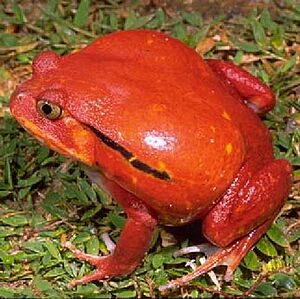Madagascar tomato frog facts for kids
Quick facts for kids Madagascar tomato frog |
|
|---|---|
 |
|
| Conservation status | |
| Scientific classification |
The Dyscophus antongilii, also known as the Madagascar tomato frog, is a type of frog. It belongs to the Microhylidae family of frogs. This frog gets its name from its bright, tomato-like color.
About the Tomato Frog
Female tomato frogs are much bigger than males. A female can grow up to 10.5 cm long and weigh 230 grams. Males are smaller, reaching about 6.5 cm and weighing 41 grams.
These frogs are famous for their bright orange-red color. Female frogs often have even brighter red or orange backs. Their bellies are usually a pale color. Some frogs might also have black spots on their throats.
Scientists believe their bright colors act as a warning. It tells predators that these frogs are not good to eat. When threatened, they can release a white, sticky substance from their skin. This substance can glue a predator's mouth shut. It can also cause an allergic reaction in humans.
Where They Live
Madagascar tomato frogs are found only on the island of Madagascar. They live in the northeast part of the island, especially around Antongil Bay. This bay is where they get part of their scientific name, antongilii.
These frogs like to breed in shallow pools and swamps. They also live in areas where water moves slowly. You can find them from sea level up to about 200 meters high. Their natural homes include wet lowland forests, rivers, and swamps. They also live in marshes, arable land, and even in urban areas. You might spot them in gardens, ponds, and canals.
Life Cycle and Habits
Tomato frogs usually breed in February and March. This happens after heavy rainfall. At night, you can hear male frogs calling loudly near small water bodies. They do this to attract females.
After mating, a female frog can lay many eggs. She might lay between 1,000 and 1,500 eggs. These small black and white eggs float on the water's surface. About 36 hours later, tiny tadpoles hatch from the eggs. They are only about six millimeters long. These tadpoles eat by filtering tiny bits of food from the water.
The tadpoles then change into young frogs. This process is called metamorphosis. They become yellow juveniles about 45 days after the eggs were laid.
Adult tomato frogs are ambush hunters. They wait quietly for their prey. They eat small invertebrates like beetles, mosquitoes, and flies. If a tomato frog feels threatened, it can puff itself up. This makes it look much bigger to scare away danger.
Protecting the Tomato Frog
The tomato frog is listed as "Near Threatened" by the IUCN Red List. This means their numbers are decreasing. They are also listed on Appendix II of CITES. CITES is an agreement that controls the trade of wild animals and plants.
The main threats to these frogs are habitat loss and pollution. People also collect these brightly colored frogs for the pet trade. This collecting was a big problem near the town of Maroantsetra. Because of this, the tomato frog was quickly added to Appendix I of CITES. This listing helps to control their international trade.
Zoos in the United States have been working to breed tomato frogs. This helps to increase their numbers in captivity. A group of zoos called the Madagascar Fauna Group (MFG) has also set up an exhibit in Madagascar. This exhibit helps to teach local people about these special frogs.
Scientists need to learn more about the tomato frog. We need to know more about where they live and how they behave. This research will help create better ways to protect them.



